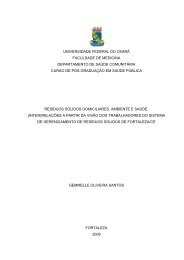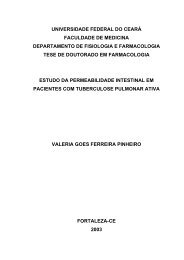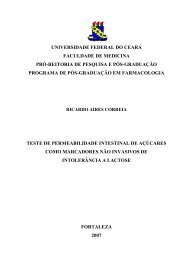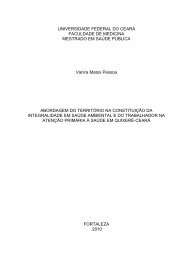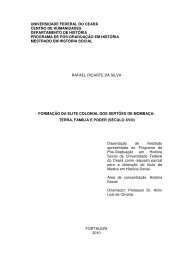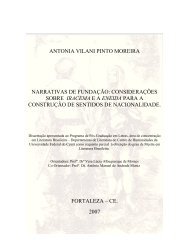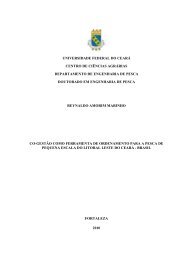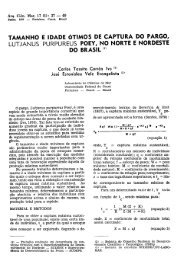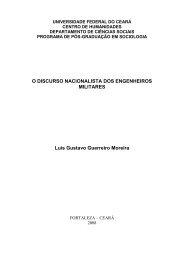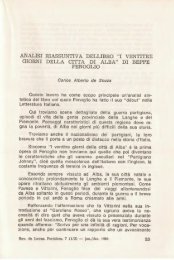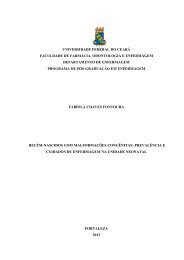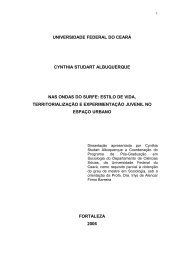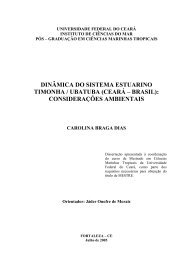Tungíase: doença negligenciada causando patologia grave
Tungíase: doença negligenciada causando patologia grave
Tungíase: doença negligenciada causando patologia grave
Create successful ePaper yourself
Turn your PDF publications into a flip-book with our unique Google optimized e-Paper software.
Table 1 Animals examined for tungiasis, the number infested and their parasitic load<br />
Lagos, Nigeria. The 1200 inhabitants are subsistence<br />
farmers, and many families keep domestic animals such as<br />
dogs, cats, goats and pigs that roam freely. Detailed characteristics<br />
of the study area and the population are presented<br />
elsewhere. 6<br />
First, we carried out a census of 50% of randomly selected<br />
households in Erekiti. Then, all households with domestic<br />
animals were visited for further investigation. After receiving<br />
the informed consent of their owners, pets and/or livestock<br />
were clinically examined over the whole body surface for<br />
the presence of embedded jigger fleas. Trapped rodents<br />
were killed with chloroform and examined.<br />
Results<br />
The overall prevalence of jigger flea infestation in the 133<br />
animals examined was 21.8% (Table 1). The prevalence<br />
and intensity of the infestation in the animals varied considerably.<br />
It was noticeably higher in pigs and dogs than in<br />
the house rat, Rattus rattus (Table 1). The median number<br />
of lesions per animal in the pigs was more than twice that<br />
found in the dogs and more than four times that found in<br />
the rats (Table 1); 83% (184/221 lesions) of the total parasite<br />
load in the animals was seen in the pigs. There were no tungiasis<br />
lesions observed in the goats, sheep, cats or cows.<br />
Discussion<br />
Prevalence No. of lesions<br />
n positive<br />
Our data confirm the notion that infestation of animals with<br />
T. penetrans in endemic communities is a common phenomenon.<br />
In the community studied, human infestation correlated<br />
with the presence of pigs in the household. 7 We can now<br />
show that, in this community which is typical for rural<br />
Nigeria, pigs in fact appear to be the most important<br />
animal reservoir, followed by dogs and rodents, for<br />
T. penetrans. Pigs were the most commonly owned domestic<br />
animals. They presented with highest parasite load and<br />
accounted for the vast majority of the total number of tungiasis<br />
lesions found in the animals.<br />
Other studies from West Africa, namely in Cameroon and<br />
São Tomé e Príncipe, also reported finding tungiasis in<br />
pigs. 3,4 Interestingly, this is in contrast to the observations<br />
in endemic communities in Brazil, where dogs and rats<br />
seem to be the most important reservoirs – free-roaming<br />
pigs were banned from endemic communities in Brazil<br />
some years ago. 1,8 Introducing the banning of free-roaming<br />
pigs in West African communities would probably also<br />
reduce human attack in that area.<br />
We conclude that tungiasis is a zoonotic disease, and that<br />
pigs, dogs and rodents are important reservoir hosts in rural<br />
Percentage<br />
(95% confidence intervals) n (%)<br />
Pigs 17/31 54.8 (36.0–72.7) 184 (83.3) 9 (6–14)<br />
Dogs 5/11 45.5 (16.8–76.6) 21 (9.5) 4 (3–5)<br />
Rattus rattus 5/17 29.4 (10.3–56.0) 13 (5.9) 2 (2–4)<br />
Mus minutoides 2/13 15.4 (1.9–45.5) 3 (1.4) 1.5 (1–2)<br />
Goats 0/28 – – – –<br />
Sheep 0/15 – – – –<br />
Cats 0/9 – – – –<br />
Cows 0/9 – – – –<br />
Total 29/133 21.8 (14.7–28.9) 221 100.0 6 (3–9)<br />
Of those with tungiasis<br />
Nigeria. Consequently, we suggest that a sustained effort is<br />
made to: reduce the ownership of pigs and dogs in these<br />
areas; educate the public about the health issues; improve<br />
the standard of housing and treat any members of the community<br />
suffering from tungiasis. Pigs should be confined to<br />
pigpens. The reduction of the rodent population will further<br />
reduce the transmission of T. penetrans.<br />
References<br />
Short Reports<br />
Median per animal<br />
(interquartile range)<br />
1 Heukelbach J. Tungiasis. Rev Inst Med Trop São Paulo<br />
2005;47:307–13<br />
2 Heukelbach J, Costa AM, Wilcke T, et al. The animal reservoir<br />
of Tunga penetrans in severely affected communities of north-east<br />
Brazil. Med Vet Entomol 2004;18:329–35<br />
3 Pampiglione S, Trentini M, Gentili F, et al. Tunga penetrans<br />
(Insecta: Siphonaptera) in pigs in São Tomé (Equatorial Africa):<br />
epidemiological, clinical, morphological and histopathological<br />
aspects. Revue Élev Méd Vét Pays Trop 1998;51:201–5<br />
4 Njeumi F, Nsangou C, Ndjend AG, et al. Tunga penetrans in<br />
Cameroon. Rev Med Vet 2002;153:177–80<br />
5 Carvalho RW, Almeida AB, Barbosa-Silva SC, et al. The patterns<br />
of tungiasis in Araruama township, state of Rio de Janeiro,<br />
Brazil. Mem Inst Oswaldo Cruz 2003;98:31–6<br />
6 Ugbomoiko US, Ofoezie IE, Heukelbach J. Tungiasis: high<br />
prevalence, parasite load, and morbidity in a rural community in<br />
Lagos State, Nigeria. Int J Dermatol 2007;46:475–81<br />
7 Ugbomoiko US, Ariza L, Ofoezie IE, et al. Risk factors for tungiasis<br />
in Nigeria: identification of targets for effective intervention.<br />
PloS Negl Trop Dis 2007;1:e87<br />
8 Muehlen M, Feldmeier H, Wilcke T, et al. Identifying risk<br />
factors for tungiasis and heavy infestation in a resource-poor<br />
community in northeast Brazil. Trans R Soc Trop Med Hyg<br />
2006;100:371–80<br />
Tropical Doctor October 2008, 38 227



